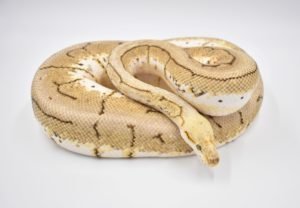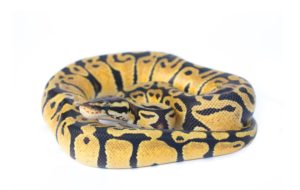Ball Python noises are either normal, or not-so-normal. What you need to know is how to figure out which is which. Let’s take a look…
Ball Python noises may be a sign of respiratory illness. In that case, it’s important to seek immediate veterinary assistance. In other cases, they be a sign of agitation, or simply physical exertion. In this article, I’ll tell you how to recognize the difference, and when to get help for your pet.
My snake is making weird noises!
If your pet snake is making weird noises, you need to find out why. Whilst certain noises are the result of physical exertion or plain grouchiness, others are a sign of illness. If you hear gurgling, wheezing, or clicking, skip any investigation and go straight to a vet – ASAP!
Generally speaking, if you keep a snake for some time you will get to know what noises are normal for it. If you spot something new, then this is always a cause for concern.
In this article, we’re going to look at the various noises Ball Pythons can make, whether they are normal, and when they could be a sign of a respiratory infection.

Ball Python squeaky breathing
One thing you may already have noticed with Ball Pythons is that they tend to be on the sluggish side. It’s fair to say they are not the athletes of the snake world… In fact, they are a species that is happy sleeping and hiding up to 18 hours a day.
This fits in with their ambush feeder background and helps them conserve energy for fasting during the breeding season. After all, you can’t hold onto weight if you’re overly active. Whilst they do enjoy exploring and foraging or even climbing, they just aren’t made for intense or prolonged physical activity.
So, when you get them out and let them explore for a while, you may notice that their breathing gets squeaky. This is part of normal Ball Python breathing. They only have small nostrils, and intense exercise gets them out of breath quickly.
This squeaking will sound even more pronounced if they get stressed out or anxious. Say, if you have them out of their enclosure for too long, for example.
Generally speaking, Ball Python squeaky breathing is nothing to worry about as long is it is just a slight whistle.
The best way to make sure it is normal is to carefully approach your snake and listen to its breathing when it is resting (without startling it!). A healthy Ball Python will have silent breathing when at rest, and the occasional bit of squeaky breathing when exerting itself.

Is it normal to hear a Ball Python breathing?
As I’ve just explained, it is normal to hear audible Ball Python breathing under certain circumstances. Stress, excitement, and physical exertion can give them a subtle, squeaky nose whistle. This is just one of their little characteristics.
There are other circumstances where their breathing may become audible however, none of which are cause for concern. One is if you surprise them and they make a hissing sound – often curling into a ball at the same time. This is just the same as when a human is surprised and they gasp at something.
Another is during feeding. Snakes like Ball Pythons swallow relatively large prey for their size and have an anatomy that is well adapted to this struggle. If you’ve ever seen an adult Ball Python eat a medium or large rat, you’ll have noticed that it takes upwards of ten minutes for them to swallow it.
During this process, snakes obviously need to continue breathing. So, in the bottom of their mouth, they have a glottis, which is an opening connected to a tough, semi-mobile tube called the glottal tube. The glottal tube connects to the trachea, which itself connects to the lungs.
Every time a snake takes a breath during a meal, it opens its glottis and gasps some air in through the glottal tube. It can do this even with a huge rat in its mouth.
The result of this breathing struggle is of course the occasional clicking and heavy gasping sound. This is the only time when these noises are normal!

Do Ball Pythons hiss?
Despite being gentle, laid-back, and even inquisitive, Ball Pythons do indeed hiss. Most often, you’ll notice them hissing when you move their hide to pick them up or clean them out.
When they’re sleeping and suddenly have their hiding place disturbed, they don’t always put two and two together and realise it’s their owner! In fact, I have several long-term captives that still hiss when I disturb them, then become totally laid back and come out for some exploring when they’ve realised it’s me.
As you might expect, this hissing is out of surprise and fear, and doesn’t mean they’re going to bite. They’re just being cautious because they aren’t exactly the biggest or toughest animals out there…
What I would consider abnormal, on the other hand, is if a Ball Python is hissing constantly. If your snake is constantly irritable and hissing, this could be a sign of illness or a husbandry error. If the snake is also restless, this may be either a sign that they are too hot or need a more secure hiding place. These issues can both cause irritability from stress.
In this situation, I would make sure that their warm spot temperatures are perfect with a digital thermometer and/or an infrared thermometer gun. I would also offer them more hiding places or smaller hiding places.
Finally, if altering these factors has no effect then you should contact a vet to give your snake a health check.
Ball Python making coughing noises
Any coughing, clicking, or wheezing noises are abnormal and need investigation. Heavy breathing and sounds that make you think your snake is struggling to breathe are almost always indicative of a respiratory infection. If you’re a reptile enthusiast, you’ll know that respiratory infections are one of the most common snake diseases.
Very rarely, a Ball Python can make a coughing or sneezing noise as a result of an allergic reaction. More on this below…
Do snakes sneeze?
Ball Pythons and other snakes are unable to truly sneeze, purely because they lack a diaphragm. In humans, it’s our diaphragm muscle that gives a violent shove to make us cough or sneeze.
Nonetheless, most animals do have some form of sneeze whatever their anatomical constraints may be, purely because it is an extremely useful function. In a nutshell, sneezing is an efficient way of clearing dust, germs and irritants from the upper respiratory tract and nasal passages.
So, whilst snakes can’t truly sneeze – they have developed their own approximation of the movement that uses their intercostal and ventral muscles. I actually saw this “snake sneeze” once and it truly freaked me out.
A long time ago, I had run out of substrate for my oldest Ball Python, Bobby. The stores were closed, it was late, and he’d peed in his enclosure. So, not wanting him to have to wait until the next day for cleaning, I replaced his substrate with paper towels.
Unfortunately, I didn’t notice that those paper towels were scented. Sure enough, a couple of hours later I heard a horrible coughing noise. When I went to check on Bobby, he was performing the “snake sneeze”. He was scrunching up his body like a concertina, making a rough coughing noise, and having explosive diarrhoea.
After panicking for about half an hour trying to figure out if he was dying, I finally checked the packaging on the paper towels and realised they were scented. I managed to find some newspaper instead, and within a few hours Bobby was back to normal.
To this day, this is the only occasion I’ve seen this happen, but I now always check the labels on anything that I bring into the snake room!

Ball Python respiratory infections
If your Ball Python is wheezing, clicking, gasping, or bubbling when at rest, it may have a respiratory infection.
Other symptoms can include:
- a swollen neck
- excess mucus around the mouth or nostrils
- drooling
- pink belly (not related to shedding)
Also referred to as upper respiratory tract infections, or RIs, this type of illness requires urgent veterinary treatment. Skip all nonsense articles and advice on home treatment and go straight to an exotics vet if at all possible!
In some cases, respiratory infections can take weeks to set in, then quickly become acute and kill a snake within a few days. It really isn’t worth trying to deal with them on your own!
When it comes to the causes of respiratory infections, the main culprits are various bacteria that live in your snake’s enclosures.
Occasionally, they can also be caused by a variety of viruses, such as Nidoviruses, for example. These cases are entirely preventable through quarantine of new pets, however. If you get a new snake, keep it in a separate room to the rest for at least six weeks!
If you take your snake to a vet for a respiratory infection, treatment can be successful, despite how dangerous the condition is. Generally, your pet will be given a course of either oral or injectable antibiotics.
These may last a week or so, and you may have to administer some at home. Don’t be afraid of this, the vet will show you how. The main thing is that you get your snake to them for treatment in the first place. Act now!
Ball Python noises summary
Turn your device to landscape if you have trouble seeing the whole table…
| Noise | Is it normal? | Action needed |
| Squeaking/whistling | Yes during exertion | None |
| Gasping | Yes during feeding | None |
| bubbling | No | Vet appointment! |
| clicking | No | Vet appointment! |
| wheezing | No | Vet appointment! |
| Hissing | Yes, but not all the time | – None unless the hissing is constant – if constant, check husbandry then contact vet if it continues |
| Coughing | No | Vet appointment! |
Also on this topic:
- How often should I clean my Ball Python’s tank?
- Ball Python Scale Rot (Necrotic dermatitis)
- How long do Ball Pythons live?
- Can I take my Ball Python outdoors?
- Can I leave my Ball Python alone while on vacation?
- Do Ball Pythons sleep?
For more on Ball Python health in general:
Back to the Ball Python health page
